Civics - Class 8
Social and Political Life - III
Chapter 3:Why do we need a Parliament?
Intext Questions
Question 1: What do you think the artist is trying to convey through the image of Parliament?
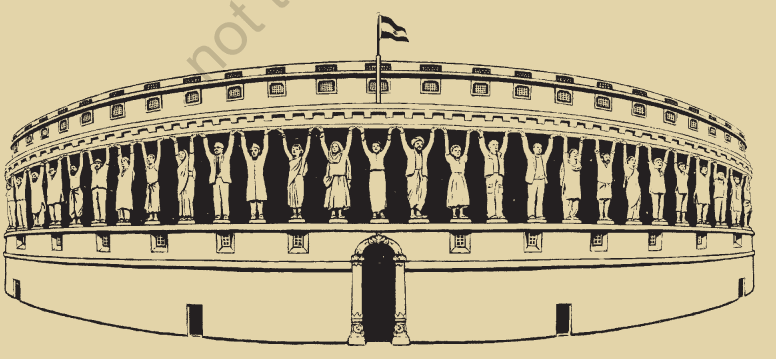
Answer :
In the image, the artist is trying to convey that our Parliament consists of people from all religious groups. Every person whether male or female, Hindu or Muslim, Sikh or Christian has equal accessibility in the Parliament. Every citizen (above 18 years) is contributing equally in building up the parliamentary form of government which has been provided by our Constitution.
Question 2: Give one reason why you think there should be a universal adult franchise.
Answer :- There should be a universal adult franchise because it gives every adult whether he/she is rich or poor, young or old, black or white, man or woman, learned or illiterate to vote or franchise in the State.
- The universal adult franchise system establishes a truly democratic government.
- It makes the government responsible to all.
Question 3: Do you think there would be any difference if the class monitor was selected by the teacher or elected by the students? Discuss.
Answer :The class monitor must be selected by the teacher and not by the students because the teacher will select the monitor by analysing or observing various qualities like intelligence, cooperation, active participation in cultural activities and performance in sports, etc. But if the students will elect the monitor, the majority could dominate minorities and the majority may misuse their power by harassing the minorities.
Question 4: Use the terms ‘constituency* and ‘represent’ to explain who is an MLA and how the person gets elected?
Answer :The country is divided into numerous constituencies. From every constituency, one candidate is elected as an MLA (Member of Legislative Assembly) who represents the people of that constituency.
MLA is directly elected by the people for a period of five years in the following ways :
- Universal Adult Franchise comprising people of all castes, creeds, and colours.
- The system of Joint representation is followed. This means that people of all castes, creeds, and colours commonly elect their representatives. There is no scope for separate electorates where only the Hindus could vote for the Hindus and the Muslims for the Muslim candidates.
- Then the system of Secret Ballot is followed. In such a system, no one can judge who has voted for whom. The candidate who gets the maximum votes is elected as a Member of the Legislative Assembly or Vidhan Sabha.
Question 5: Discuss with your teacher the difference between a State Legislative Assembly (Vidhan Sabha) and the Parliament (Lok Sabha).
Answer :State Legislative Assembly (Vidhan Sabha) is the lower house of the State legislature in India. Members of the Vidhan Sabha are direct representatives of the people of the particular State as they are directly elected by an electorate consisting of all adult citizens of that State.
Lok Sabha is composed of representatives of people chosen by direct election on the basis of adult suffrage. It is the lower house of the Parliament.
Question 6: From the list below, identify the work of a State government and that of a Central government.
- The decision of the Indian government to maintain peaceful relations with China.
- The decision of the Madhya Pradesh government to discontinue Board exams in Class VIII for all schools under this Board.
- Introduction of a new train connection between Ajmer and Mysore.
- Introduction of a new 1,000 rupee note.
- Central Government
- State Government
- Central Government
- Central Government
Question 7: Fill in the blanks with the following words
universal adult franchise; MLAs;
representative; directly
Democratic governments in our times are usually referred to as representative democracies. In representative democracies, people do not participate directly but, instead, choose their representatives through an election process. These MLAs meet and make decisions for the entire population. These days, a government cannot call itself democratic unless it allows what is known as a universal adult franchise. This means that all adult citizens in the country are allowed to vote.
Question 8: You have read that most elected members whether in the Panchayat, or the Vidhan Sabha or the Parliament are elected for a fixed period of five years. Why do we have a system where the representatives are elected for a fixed period and not for life ?
Answer :For the Panchayats, or the Vidhan Sabha or the Parliament members are elected for a fixed period of five years and not for life because of the following reasons :
- The majority party or parties in the Parliament govern the country according to the will of the people.
- The majority party cannot dominate minorities.
- Besides working for the progress of the nation, they also concentrate on welfare activities and upliftment of women and lower castes.
- If people are not satisfied by the policies or performance of the ruling party, they can change the government after five years through a universal adult franchise.
Question 9: You have read that people participate in other ways and not just through elections to express approval or disapproval of the actions of the government. Can you describe three such ways through a small skit?
Answer :The three ways in which the skit can be performed are:
- A group of students can campaign against the wrong policy of the government.
- A group of students can also take out an article in the newspaper against the wrong done by the ruling party.
- Another group of students can present their approval or disapproval through media (television) of the actions of the government.
Question 10: Use the below table to answer the questions being followed:
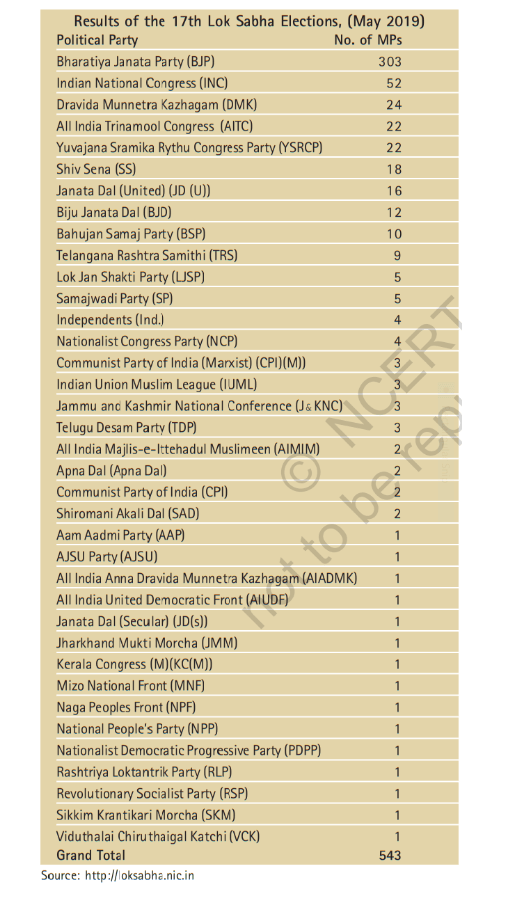
A. Who will form the government? Why?
Answer : Bharatiya Janata Party will form the government because it has got a maximum of 303 seats.
B. Who will be present for discussions in the Lok Sabha?
Answer : All those members of National or Regional Political Parties that are elected as members of Parliament (MP) from any constituency are entitled to be present for the discussions in the Lok Sabha.
C. Is this process similar to what you have read about in Class VII?
Answer : Yes, this process is similar to what we have learned in Class VII.
Question 11: The photograph on page 28 shows results from the 3rd Lok Sabha elections held in 1962. Use the photograph to answer the following questions :
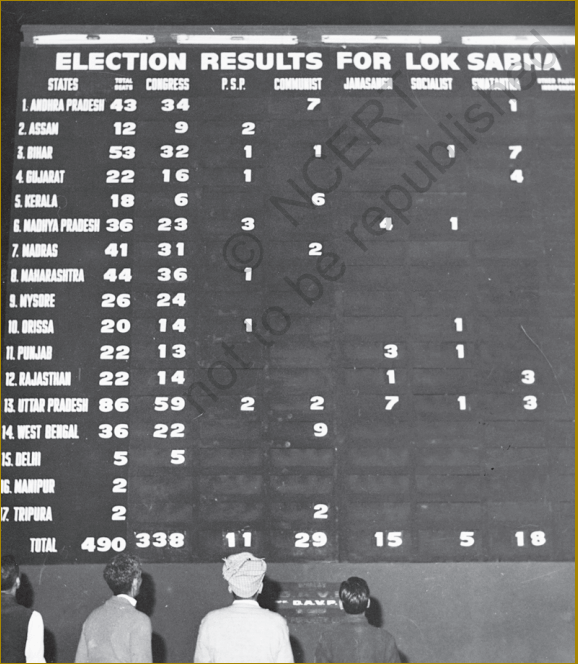
(a) Which state has the highest number of MPs in the Lok Sabha? Why do you think this is so?
Answer :Uttar Pradesh has the highest number of MPs in the Lok Sabha because the number of constituencies is the highest in comparison to other states.
(b) Which state has the least number of MPs in the Lok Sabha?
Answer :Tripura has the least number of MPs in the Lok Sabha.
(c) Which political party has won the most seats in all states?
Answer :Congress has won the most seats in all states.
(d) Which party do you think will form the government? Give reasons why.
Answer :Congress will form the government because it has gained the maximum number of votes from all the states.
Question 12:
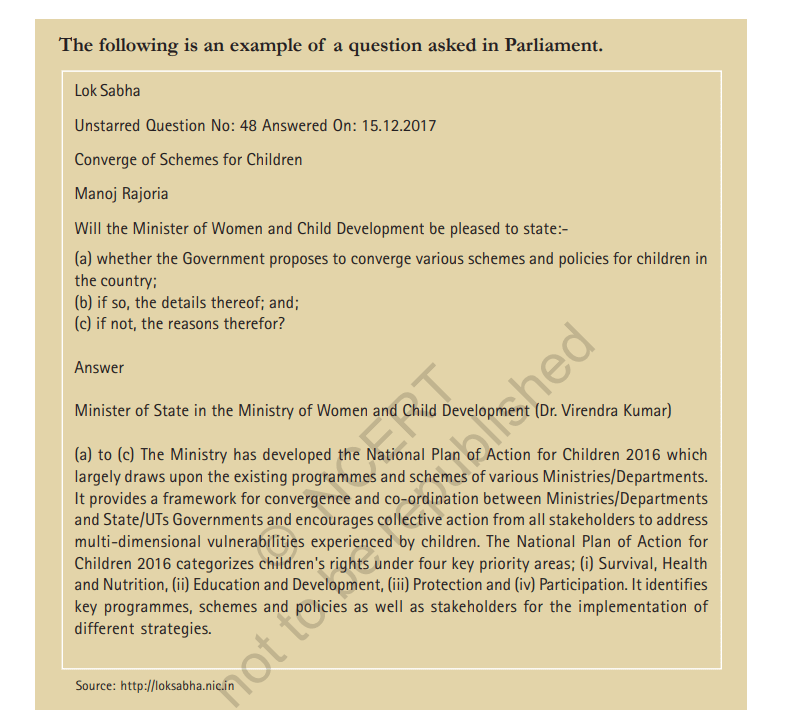
A) In the above question what information is being sought from the Minister of Women and Child Development?
Answer :The information being sought from the Minister of Women and Child Development is that what schemes and policies are being formed for children for their growth in all formats like health, education, nutrition and their mental status etc.
A) The details of the running schemes and policies and programmes of children in the country. If not any policies,
B) The reasons for not having any policies and schemes.
B) If you were a Member of Parliament (MP), list two questions that you would like to ask.
Answer :i) What are the programmes running for nutrition of children in India and protection of children from pollution and infanticides?
ii) What are the policies running for orphan children in India.
Question 13: Looking below table, would you say that people’s participation during the past 65 years has decreased/increased/been stable after the initial increase?
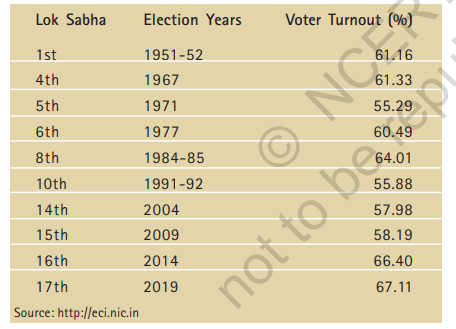
Answer :
It has been stable after the initial increase.
Question 14: Why do you think there are so few women in Parliament? Discuss.
Answer :There are so few women in Parliament because :
- They have a lack of interest in politics.
- Females are less encouraged by their guardians to enter into politics. Besides, they are advised to opt for other jobs such as a doctor, teacher, etc.
- Women prefer to spend their time with their children or family despite entering into politics.
Exercises
Question 1: Why do you think our national movement supported the idea that all adults have a right to vote?
Answer :Under colonial rule, the people had lived in fear of the British govt. & did not agree with many of the decisions that they took.- But they faced great danger if they tried to criticize these decisions.
- The freedom movement changed this situation & the nationalists began to openly criticize the British government & make demands.
- They demanded that there be elected members in the legislature with a right to discuss the budget & ask questions.
That is why nationalist movement supported the idea of universal adult franchise, so that the people can take part in the decision making of the country.
Question 2: In this 2004 map of Parliamentary constituencies alongside, roughly identify the constituencies in your State. What is the name of the MP from your constituency? How many MPs does your state have? Why are certain constituencies coloured green while others are coloured blue?
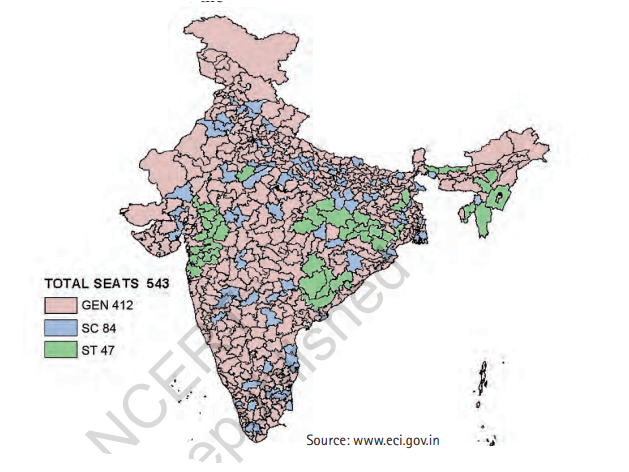
Answer :
My native state is Andhra Pradesh. It has 42 constituencies in total and 1 M.P. from each constituency hence 42 M.P.S. in total.
My constituency is Nandyal and my M.P. is S.P.Y. Reddy garu.
In the above diagram certain constituencies are colored Green, because they are reserved for S.T. candidates and they are 47 in number.
Some constituencies are coloured by blue, because they are reserved for S.C. and they are 84 in number.
Question 3: You have read in Chapter 1 that the ‘Parliamentary form of government’ that exists in India has three tiers. This includes the Parliament (central government) and the various State Legislatures (state governments).
Fill in the following table with information on the various representatives from your area:
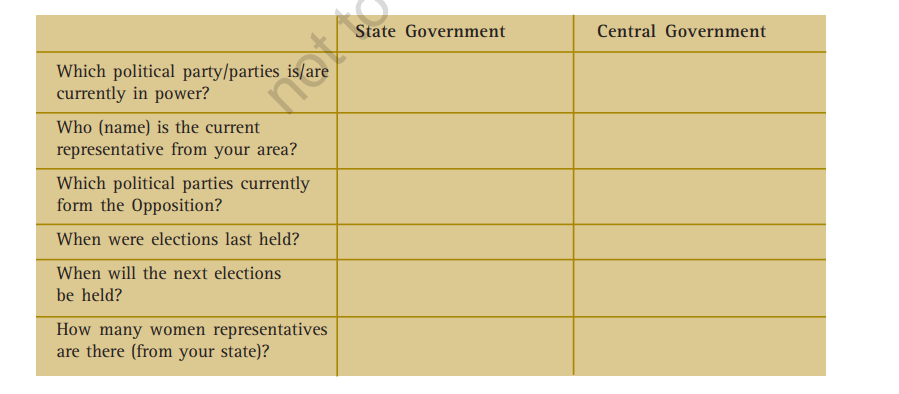
Answer :
Central Government |
State Government |
| 1. B.J.P.(N.D.A) | Jagan's Y.S.R. Congress party. |
| 2. P. Brahmananda Reddy (M.P.) | Gangula Brijendra Reddy(M.L.A.) |
| 3. None | T.D.P. |
| 4. 2019 | 2019 |
| 5. 2024 | 2024 |
| 6. 4 | 14 |